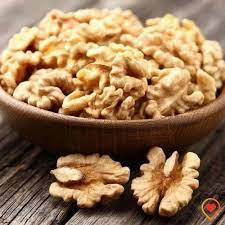.jpeg)
Walnuts, often hailed as “brain food,” are a nutritional powerhouse packed with omega-3 fatty acids, antioxidants, vitamins, and minerals. While these nuts are undeniably healthy, the way you consume them can significantly impact how well your body absorbs their key nutrients. Let’s uncover the secrets to eating walnuts the right way so you can reap their full health benefits.
The Nutritional Power of Walnuts
Walnuts are rich in:
- Omega-3 Fatty Acids: Essential for brain health, reducing inflammation, and supporting heart health.
- Antioxidants: Protect against oxidative stress and reduce the risk of chronic diseases.
- Vitamins and Minerals: Vitamin E, magnesium, phosphorus, and copper contribute to bone health, immunity, and energy production.
- Protein and Fiber: Promote satiety, aiding in weight management and digestive health.
However, improper consumption can lead to nutrient loss or reduced absorption. To truly harness their benefits, you need to pay attention to how you store, prepare, and consume walnuts.
The Right Way to Eat Walnuts

1. Soak Walnuts for Maximum Nutrient Absorption
Raw walnuts contain phytic acid, an anti-nutrient that can bind to minerals like iron, zinc, and calcium, reducing their absorption. Soaking walnuts helps deactivate phytic acid and makes the nutrients more bioavailable.
- How to Soak Walnuts:
- Take a handful of walnuts and place them in a bowl of water.
- Add a pinch of salt to enhance the soaking process.
- Leave them overnight or for at least 6-8 hours.
- Rinse well before consuming.
- Soaked walnuts are also easier to digest and have a softer texture, making them ideal for people with sensitive stomachs.
2. Avoid Roasting at High Temperatures
While roasted walnuts are delicious, high heat can destroy their delicate omega-3 fatty acids and reduce antioxidant levels.
- If you prefer roasted walnuts, opt for dry roasting at a low temperature (around 150°C or 300°F) for 10-15 minutes. This retains the nutrients while enhancing the flavor.
3. Pair Walnuts with Vitamin-Rich Foods
To maximize nutrient absorption, pair walnuts with foods rich in vitamin C (like citrus fruits or berries). Vitamin C enhances the absorption of iron and other minerals found in walnuts.
- Example: Add walnuts to a spinach and orange salad or pair them with a smoothie made from strawberries and yogurt.
4. Eat Walnuts in Moderation
While walnuts are nutrient-dense, they are also calorie-rich. Overeating them can lead to excessive calorie intake, which may hinder weight management efforts.
- Recommended Portion: Stick to a serving of 1 ounce (about 7-8 walnut halves) per day to strike the right balance.
5. Consume Them Fresh

Walnuts are prone to rancidity due to their high-fat content. Eating stale or rancid walnuts not only affects the taste but also reduces their nutritional value.
- Storage Tips:
- Store walnuts in an airtight container in the refrigerator or freezer to preserve their freshness and prevent oxidation.
- Avoid exposing them to heat or sunlight.
6. Blend Walnuts into Meals
Walnuts are versatile and can easily be incorporated into various dishes:
- Smoothies: Blend soaked walnuts into your morning smoothie for a creamy texture and nutrient boost.
- Salads: Sprinkle chopped walnuts on salads for added crunch and omega-3 goodness.
- Oatmeal or Yogurt: Add walnuts to your breakfast bowl for a fiber-rich start to your day.
- Baking: Use ground walnuts as a base for energy bars, cookies, or muffins to enhance the nutritional profile.
7. Combine Walnuts with Healthy Fats
Pairing walnuts with other healthy fats, like olive oil or avocado, can enhance the absorption of fat-soluble vitamins (A, D, E, and K) present in your meal.
- Example: Make a walnut pesto with olive oil and basil or toss walnuts with avocado slices in a salad.
Common Mistakes to Avoid
- Eating Salted or Flavored Walnuts: Store-bought salted or candied walnuts may be high in sodium or added sugar, negating their health benefits. Always opt for plain, unsalted walnuts.
- Skipping Soaking or Low-Temperature Roasting: Raw walnuts can be difficult to digest, and high-temperature roasting destroys nutrients, so always prepare them correctly.
- Overeating: Despite their health benefits, consuming too many walnuts in one sitting can lead to digestive discomfort and excess calorie intake.
The Health Benefits of Eating Walnuts Correctly
By consuming walnuts the right way, you can unlock their full potential and enjoy these amazing health benefits:
- Improved Brain Health: Omega-3s in walnuts boost memory, focus, and cognitive function.
- Heart Health: Walnuts lower bad cholesterol (LDL) and reduce the risk of heart disease.
- Weight Management: The fiber and protein in walnuts keep you fuller for longer, reducing hunger pangs.
- Better Digestion: Soaking walnuts makes them easier to digest and supports gut health.
- Stronger Bones: The magnesium and phosphorus in walnuts strengthen bones and improve calcium absorption.
The Bottom Line
Eating walnuts the right way ensures that your body absorbs their key nutrients, making them even more beneficial for your health. By soaking, roasting at low temperatures, and combining them with nutrient-rich foods, you can maximize their potential. Whether you toss them into your salads, blend them into smoothies, or snack on them in moderation, walnuts are a delicious and versatile way to nourish your body.
So, the next time you reach for this crunchy superfood, remember to crack the code to eating walnuts the right way! Your body—and taste buds—will thank you.
